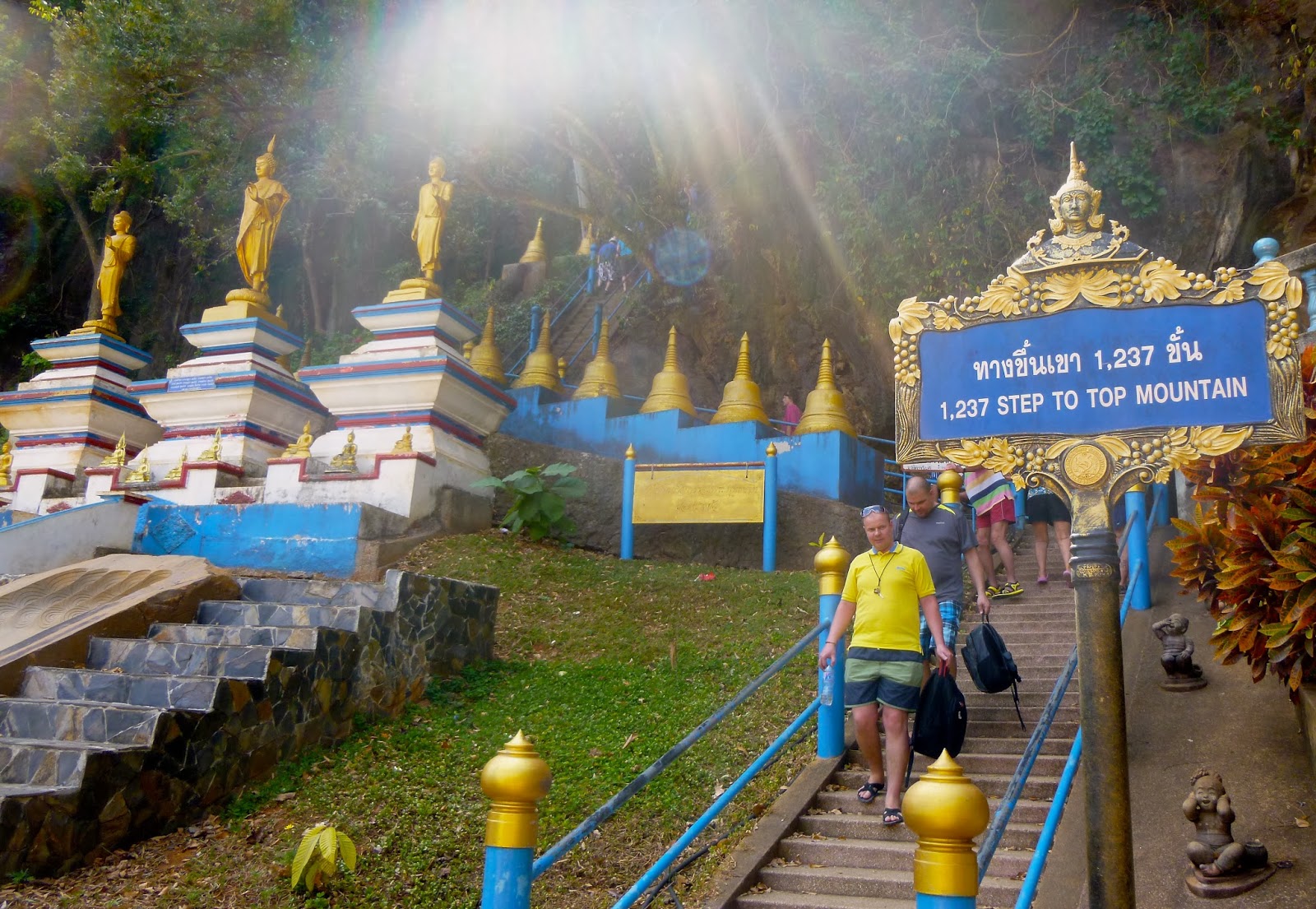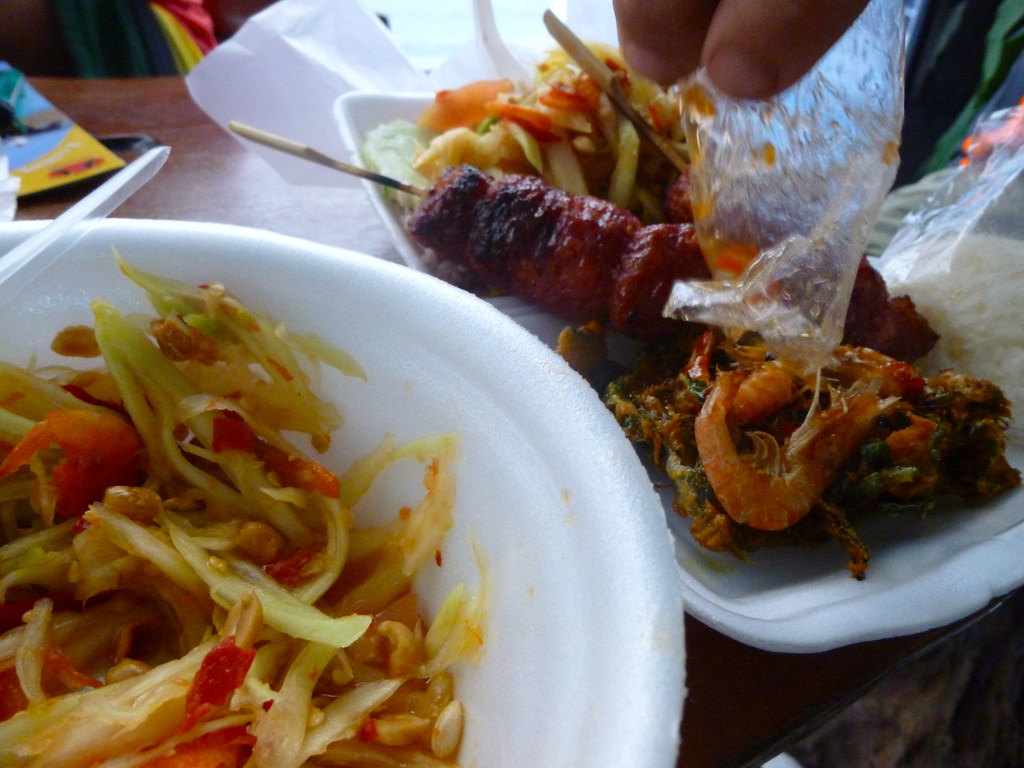 |
| Landing at Moo Too Pier, Kho Jum |
4 February – 12 February
Making it to Kho Jum, I find it is just
as crowded as the rest of Thailand. This island K. found online
before we left Maine, an island not in Lonely Planet, with 150B
bungalows, allegedly off of the beaten track. And then in Bangkok,
during our first week, we met a Finn engaged to a Thai who lived on
Kho Jum. We made plans to meet. We got our hopes up—authentic
Thailand. Markets and street food and long stretches of empty beach.
Our Finnish friend told us that locals
don't take the ferry, they take the taxi boat, so we knew that one
existed and managed to get from Phun Phin all the way to Kho Jum in
less than twelve hours—and all the way from Georgetown to Kho Jum
in less than 24—a traveler's feat I remain proud of. We checked out
of our hotel at eleven, had a leisurely breakfast of curry and fish,
caught the local bus, and pulled into the bus station the minute
before the government bus to Krabi was pulling out, just by luck, and
took its last two places. Standing room only, at the front. The bus
left within seconds, and we looked back to see the whole back half
stuffed full of farangs, heading to Kho Phi Phi or Lanta or another
island for their vacation. As, incidentally, are we.
What did one tourist say to the other
tourist?
“Man, there are so many tourists
here.”
Sometimes I feel like I am just a
hypocrite, complaining about all of the travelers while being one
myself. The fact remained that we were the last two farangs on a bus
full of them, one of whom was hogging an entire seat with his baby
backpack, the daypack that he wears on front like a Baby Bjorn while
walking around town. I shot daggers and bad karma at him with my
eyes. For a while I sat on the floor among the giant backpacks below
knee level of standing and swaying Thai girls, the ones just going
halfway, fanning their sweating foreheads as I tried to catch the
breeze.
But unlike many travelers, we try to be
respectful. We attempt to speak Thai and act and dress respectfully,
failing often. Unlike the Italians at the back of the bus who
started taking off their shirts (most were wearing bikinis beneath)
and yelling at each other about how much Thailand sucked in Italian.
A German in Kho Phayam told me, authoritatively, that Italian was the
most beautiful language, and when I suggested Thai, he dismissed it
as guttural and awful. I hear it as music. Anyone who thinks
Italian is the most beautiful language should hear hungover
college-age Italians yelling about how horrible Thailand is while
standing in a 100-degree (38-degree Celsius) bus.
We took a sohngtaeuo to the taxi boat,
effortlessly but expensively, catching what I thought was the last
boat at 5:30pm. The guy at the bus station had told us 5. It's the
boat our Finn friend told us the locals took, a boat with no farangs
on it. The island appeared, dusty and numinous at sunset. We're the
only travelers on the pier, and on the dusty taxi drive to our
friend's restaurant we imagine we've finally found paradise. The
restaurant I picture as a small local one, with a glass case and
plastic chairs and cousins and nephews hanging around. I imagine I
can learn Thai here, study.
Then we arrive and already elderly
British and German couples are filling the place with $7-schnitzel
orders. The island is full, we are informed. No bungalows anywhere.
Even the mythical 150B and 200B ones, which exist on this island, are
full. We taxi to one bungalow where she offers to let us sleep on
the floor in her restaurant. We go to another and wake up the owner.
He shows us a beautiful villa, made of bamboo and teak, up on the
hill—but on the other side of the road from the beach. We take it,
for 500B.
We ended up staying a week. I loved
it—the teak bench on the bamboo porch, surrounded by rubber trees
and garden and hibiscus. Although we are twelve minutes from the
beach, and don't even get there every day, don't even swim every day.
When we first arrived at Kho Phayam, our last island, we scoffed at
Lonely Planet, which said the days of 200B beachfront bungalows are
over. Already we'd found a 600B one, only three rows back, and 300B
cheapies behind us. But the cheapies are always booked, and when
they're not, they're concrete bunkers by the generator, facing away
from the ocean. It's possible to stay for 200B on a Thai island, but
you may be on the other side of the road.
I'm still complaining about expense.
The fact is that many things here are more expensive now that in the
States. Coffee, for one. Drinks. $1 in the US gets you a 20-ounce
soda and free ice, or a bottomless soda at McDonald's. Here you pay
$1 for a bottle and extra for ice. Water. For a while we were
spending 160B a day on bottled water, because we can't drink tap
water.
Maybe we could just be cutting back in
Thailand on things like coffee and three meals a day, but instead
it's increasingly clear that Thailand is no longer on the hippie
trail. Seven-dollar meals are cheap for Danish pensioners or French
retirees or Dutch families on a package tour. But for us, with no
car, no fridge, no access to a market, and no cooking facilities—we
find ourselves stranded. And also, while complaining about costs, I
realize how cheap so many things still are. Why can't I just allow
myself to enjoy the time?
We do, as much as possible. Long
mornings laying in the hammock on the porch. Long walks on the beach
after dark—better than taking the road. Finding a restaurant (even
if farangified) that makes us khao dtom goong (rice soup with
shrimp) and puts an egg in it, poached in broth. I'm trying to let
costs go, as much as possible, not let it gnaw at me. Maybe it's the
primary response of people returning to their homeland, shock at how
much prices have gone up.
If it wasn't so malicious. I was proud
of our 24-hour travel day until I realized we were over charged every
step of it—5B on the local bus, 30B on the government bus, 40B by
the sohngtaeuo, 20B by the boat, 20B by the taxi. Maybe not much,
but it adds up--$4 a day. The farang tax, we call it. The
consistent over-charging by Thais for travelers. We see things
printed on menus in English, other listings in Thai. We watch the
price paid by a Thai and then paid by a westerner. Often, as my Thai
improves, I hear that the prices given in Thai are less.
I made friends with one restaurant
owner here who is scrupulous in her prices to us, and we keep coming
back to her, although her prices are also high. I ask her why so
many people do it. Our Finnish friend sometimes thinks it's gouging,
charging 65B for a coffee because one can. And then there's the
contrast with the poverty. Why should I begrudge a coffee that costs
$2.50 if the person making it is only making 500B a day? But it
doesn't seem fair. I feel angry when I go to Starbucks at a service
plaza in the States and buy an overpriced coffee, because it's
overpriced. But it's fair. The price listed is charged to everyone,
regardless of race. Taxes are the same.
It just doesn't feel like the Thailand
of my youth. People have hardened, grown calloused against farangs.
Have grown calloused to our money. It's not a surprise, considering
how little respect we have, in general, towards Thai culture. It's
like I want to convince Thai people I can be a human being.
I said, on our first night in Kho Jum:
“I don't know if it's because my parents spoke better Thai, or
because there were fewer farangs, or because it was fifteen years
ago, but I don't remember being overcharged like this.”
K. said: “Probably all of those.”
It just leaves a sour taste in your
mouth, like you're made constantly to feel stupid. This country is
beautiful, its language, culture, food, and people exquisite—and
instead of the “radiant hospitality” promised by guidebooks, the
hospitality I remember—I feel this simmering racism.
It's hard to explain, because then it
can seem like the entire experience has been negative. This exists,
but these other layers exist, too, of beauty and kindness and
generosity. I am as in love with the Thai language as ever, maybe
more so. I learn something new from every Thai conversation. The
landscape here is the one I belong in. The culture is alien and
confusing, but almost all Thais are gracious, wonderful people.
The hardest ones are those we have to
deal with most often, the ones directly on the tourist trail, bus
drivers and boat drivers and guesthouse owners and travel agents.
And understandably so, based on the farang behavior we've seen. In
Bangkok a French couple yelled at the guesthouse owner for two hours
because they'd taken a 200B taxi to his place for a reservation that
didn't exist. He paid for their cab. The cleaning lady, gentle and
kind, who did our laundry for almost nothing—stood by the desk,
horrified. In Surat Thai, in the middle of the night, a British girl
yelled at the entire railway station staff for a full hour, in
English and incomprehensible Thai. “I want my f***ing bonnets!”
she said. Evidently someone at the station had taken her motorcycle
helmets, or she'd left them—it wasn't clear. He came back with
them, eventually. On Kho Phayam, a French woman left a
restaurant—little more than a streetside stand—when her green
papaya salad didn't come soon enough. “I wait, and wait, and
wait...” This at a stand where they had the cheapest food on the
island, the entire place packed, and one person cooking.
It's incomprehensible to me. I feel a
constant consciousness of being in a foreign culture, and attempt to
act respectfully, knowing that all the while I'm trampling
restrictions I know nothing about. So the least I can do is be
polite.
Maybe the best part of Kho Jum was its
limited internet access. Finally, a place free of wifi. Not exactly
free, because the nicer resorts did have it, at glacial speeds, and
there was one internet cafe in town. But I spent a week not worrying
about it, lounging in the hammock, taking a break from the road. We
thought about finding another bungalow, closer to the beach—one of
the mythical 200B ones is opening up. But I think we'll leave.
Maybe we're done with the islands. As much as I love the beach, I'm
ready to go to the farthest corner of Thailand to see if there's any
place left away from the crowd.







